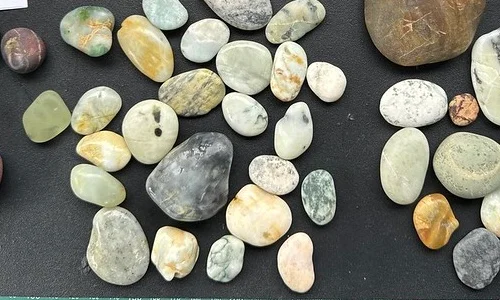These coastal treasures from Gemstone Beach are mainly hydrogrossular garnets or smooth stones that don’t need to do a tumble in the coarse grit 80/100grit. Those smoother stones are most likely to be argillite which is a prevalent type of stone found on Gemstone Beach. Argillite is a type of mudstone which is a clastic sedimentary rock.
Hydrogrossular Garnets
After several fossicks at Gemstone Beach my collection of various types of hydrogrossular or grossular garnets has increased significantly. From brown, to pink, to white to the highly prized green types, I’ve also managed to find some grey/black hydrogrossular garnets.
On recent fossicks in March 2024 (with JP) we both noticed that there were a LOT of hydrogrossular garnets appearing all along Gemstone Beach from the Tanoa Stream and Waimeamea River. Usually the hydrogrossular garnets are on the smaller scale but recent finds have been quite a bit larger.
In 1943 mineralogist Colin Hutton gave the name hydrogrossular to a calcium-rich variety of garnet that is the main constituent of the rock rodingite, also named from New Zealand. As the name indicates, it contains some water. Recent research has shown that most of what was previously described as grossular garnet contains some water, and is better described as hydrogrossular.
Hydrogrossular ranges from yellowish brown to pale green. Rounded pebbles are found on some Southland beaches, and it has been used for carving.
https://teara.govt.nz/en/rock-and-mineral-names/print (accessed 7 April 2024)
Batch 54: 3lb Tumbler 1
Stage 2: 220grit
Number of Stones: 49
Weight in: 885g
4 Tbspns of 220grit
1 Tbspn Borax
Ceramic media added
Days Tumbling: 10
Weight out: 780g – loss of 105grams
Stage 3: 400grit
Number of Stones: 36+35+3=74
Weight in: 646g
2 Tbspns of 400grit
No Borax added (run out)
Plastic pellets added
Days Tumbling: 10
Weight out: 609g – loss of 37grams
Notes/Observations
I took out 13 stones after Stage 2 because they needed redoing. I added 35 readies (stones) from Gemstone Beach and 3 more stones from the redo box (which were polished but didn’t have a satisfactory finish) to the barrel for tumbling in 400-grit.
In an effort to work on getting a better shine/polish finish of the tumbling stones I’ve decided to not only pay attention to the level of stones in the barrel – ⅔ full (which I’ve posted several times already) PLUS I’ve read on several occasions that other rock tumblers use only 1 Tablespoon of grit per pound of rocks. Since I already weigh stones at the start and end of each stage it is really easy to use a conversion app to get the pound weight. For example, 646 grams equals 1.42 lbs therefore 2 tablespoons of 400grit was added to the barrel.
Batch 54: Pre-tumble
Batch 54: After 220grit
At the end of 400grit, two hydrogrossular garnets were put back in the redo box along with four other stones that were not ready for polish.
After 48 hours in a Pre-polish Soap Tumble I carefully dried and closely inspected all of the stones. I’ve been following the videos from Rob at Michigan Rocks and have taken note of his very particular high standard of not moving rocks on unless they are smooth and have no scratches, pits or gouges that could potentially carry grit that contaminates the next stage. Rob will either chisel any fractures or gouges/pits or grind them out. He also uses a needle to clean out grit from holes. If a rock is allowed to continue it’s tumbling journey but it has deep holes (that couldn’t possibly be tumbled out) Rob puts them aside and tumbles them with similar rocks as those holes have the potential to carry grit inadvertently to the next stage. This is not good as the coarser grit could scratch the smoothed stones.
Transfer to 3lb Tumbler 4
After waiting in the readies drawer for quite some time (over a month) I was able to add Batch 54 stones to 3lbT4 (and Batch 58) for the polish tumble.
Stage 4: Tumble Polish Mix
Number of Stones: 67 + 34 =103
Waited for in the “Readies holding drawer” for over a month.
Weight in: 495+378g=873g
Polish Mix (2nd use): 9 Tbspns of polish mixed with 600mls of water. Plastic pellets added.
Days Tumbling: 10
Weight out: 870g – loss of: 3 grams
Borax Final Clean
1 Tbspn of borax, plastic pellets for cushioning and 48 hours tumbling.
Lots of “grey” floating on the top of the polish indicates contamination. This shows me that a soap tumble prior to polishing is important.
As I reuse the polish I try to sieve a lot of that “grey” off by using a muslin cloth on top of the sieve when tipping back into the polish container.
Polish Complete
Polished Stones of Interest: Batch 54
Batch 54 | 3lb Tumbler 1 | Gemstone Beach | 16 March – 5 April
3lb Tumbler 4 | Batch 54 and Batch 58 | 21 May – 2 June 2024









